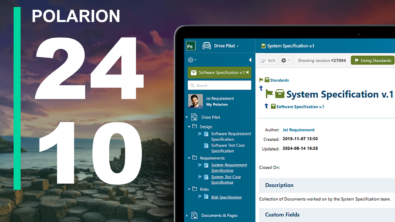Polarion ALM 2404 – What’s New and Noteworthy
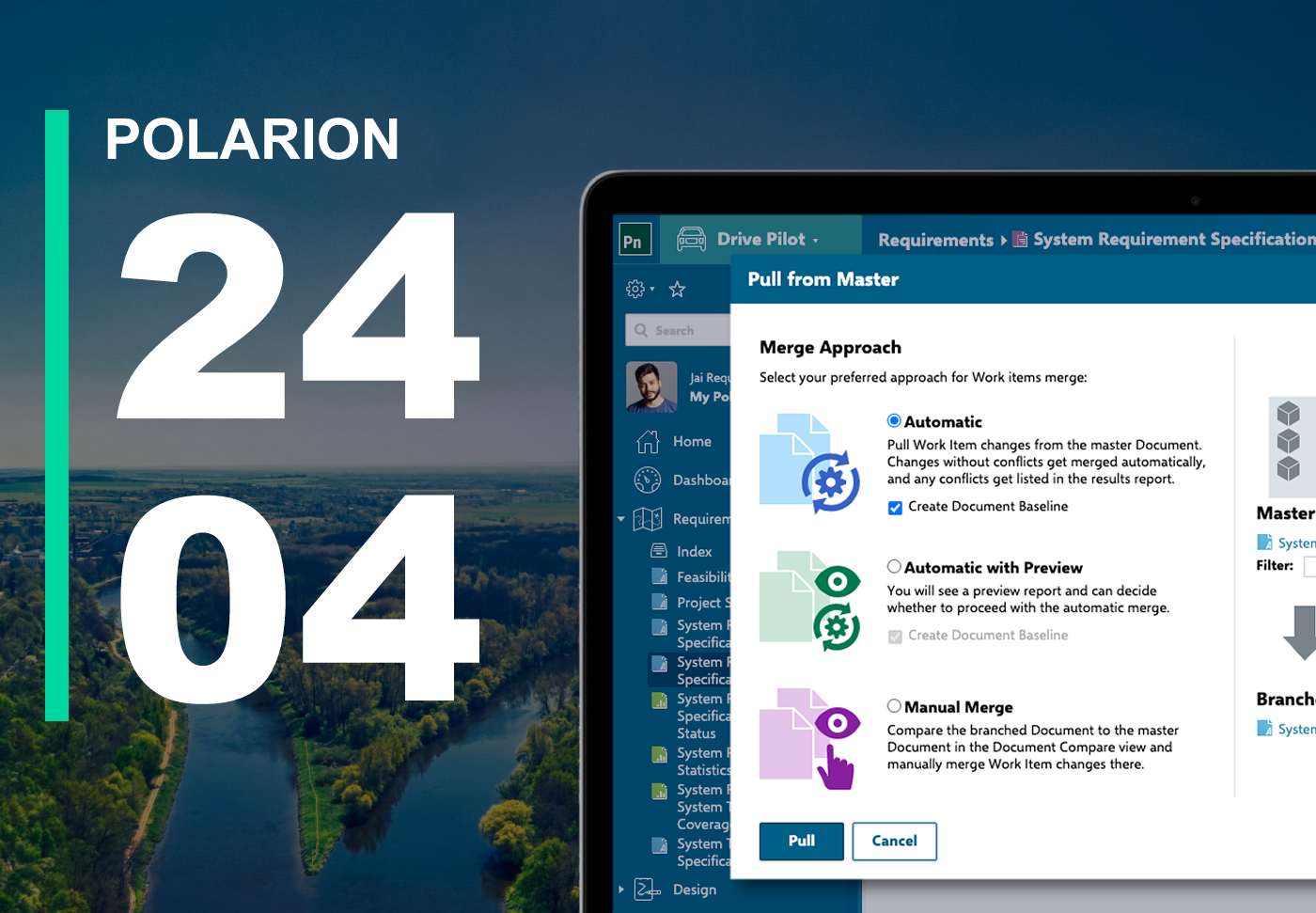
Welcome to the unveiling of our latest release, Polarion 2404. At Polarion, we’re dedicated to continuous improvement, and with this release, we’re excited to introduce several significant updates based on user feedback and innovation. Here’s a glimpse at what’s new:
- Automatic Merge of LiveDoc Changes: Easily merge changes between master and branch Documents with just one click.
- Improved Test Management: Enjoy a more flexible and robust test planning and execution process.
- Project and User Isolation: Benefit from better separation of projects and their users.
In this blog post, we’ll explore these pivotal additions, fresh features, and enhancements and highlight the latest security, performance, and quality improvements. Join us as we explore the exciting updates that Polarion 2404 has to offer!
New Automatic Merge
In Polarion 2310, we introduced the bulk document branching capability as part of our continued focus on reuse. Now, we are ready to unveil the next phase of that journey with a new feature that allows the automatic merging of changes between master and branched documents. Don’t worry; you can still manually merge changes between Documents using the existing ![]() Compare and Merge actions (now called Manual Merge).
Compare and Merge actions (now called Manual Merge).
The new ![]() Automatic Merge supplements the existing Manual Merge capabilities.
Automatic Merge supplements the existing Manual Merge capabilities.
Automatic Merge provides a way of merging trivial changes automatically, so you don’t have to click through each change one by one. The Automatic Merge feature uses a proven 3-way merge technique to detect changes between master and branched documents. We are able to merge Work Item modifications, deletions, and additions from branch to master Documents (push action), as well as from master to branch Documents (pull action). Merges are done at the Field level so that if the same Work Item but different fields are modified in both branch and master Documents, they can be automatically merged.
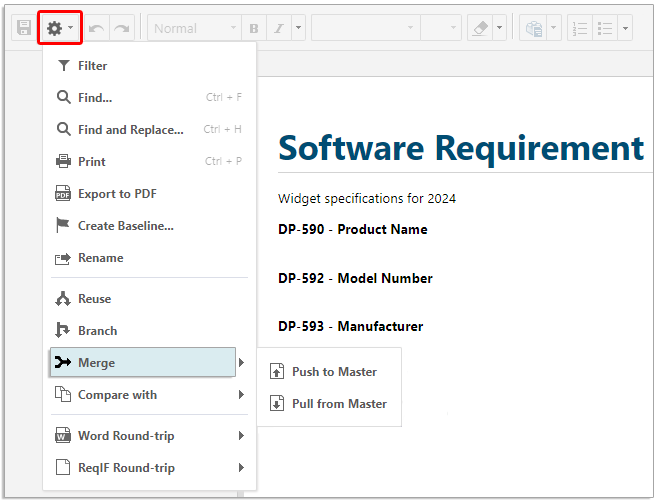
In the new Automatic Merge dialog, you can choose to preview the merge before it makes any changes to the target Document. This is called Automatic with Preview. Alternatively, you can just go ahead and merge without the preview. You also have the option to use the existing compare view and Manual Merge functionality if you wish.
For convenience and transparency, the new Automatic Merge dialog offers the option to create a Document Baseline when automatically merging, with an additional description field showing what changes were made to the Document.
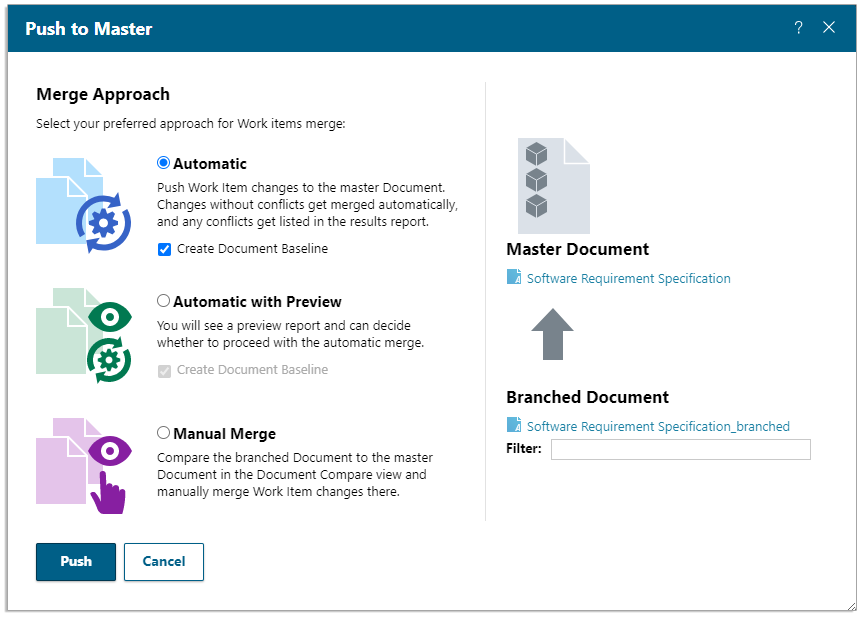
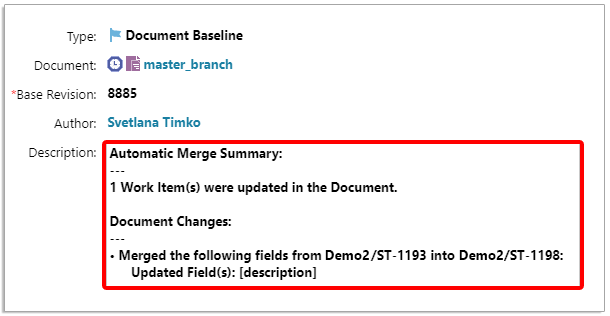
Automatic Merge also works with filtered Documents. You can even apply an additional filter to the source Document and choose only to merge changes and Work Items with the additional filter applied.
After the merge, the system reports what was merged, and you can view a detailed log.
You can also open the ![]() Compare view to see the changes made.
Compare view to see the changes made.
If Polarion detects conflicts it cannot merge, you are informed and can choose to merge those changes manually.
Lastly, in Administration, you can tailor Automatic Merge’s actions to your liking. This includes changes in Work Item fields and the insertion and deletion of Work Items.
Improved Compare and Manual Merge
We have improved the existing Compare view and merge actions to better align the new Automatic Merge feature with the existing Manual Merge functionality. You will see them when you Compare two Documents and switch to the Work Items view. Some of the improvements are also available when comparing different revisions of a single Document.
Exposing additional fields in Document compare
We now display the Status field in the Work Item comparison view. This is very helpful, as some customers want to merge only Work Items that are in the Approved state and ignore all other Work Items, even if there are changes between them.
Now, you can quickly find and concentrate on those Approved Work Items during the Manual Merge.
Merging of filtered Documents
The second improvement we made is that you can finally merge branched Documents initially created from a filtered master document! This wasn’t possible before, but that restriction has been removed, and Manual Merge now supports this use case. (You can also do it with the new Automatic Merge feature!)
We also improved how Work Items not matching the current filter are shown in the comparison. Now, if a Work Item on one side of the comparison exists in the target Document but does not match the filter, it is shown and tagged with a “Filtered out” label instead of acting like it does not exist.
Streamlined presentation of real changes
The final improvement we made was to help simplify the information presented in the Work Item comparison view by offering users different display options. For example, you may have chosen to overwrite all the referenced Work Items in a branched Document but have made no additional changes to those Work Items yet. With one of these new display options, you can now choose to ignore those overwritten referenced Work Items and instead concentrate on other Work Items changes.
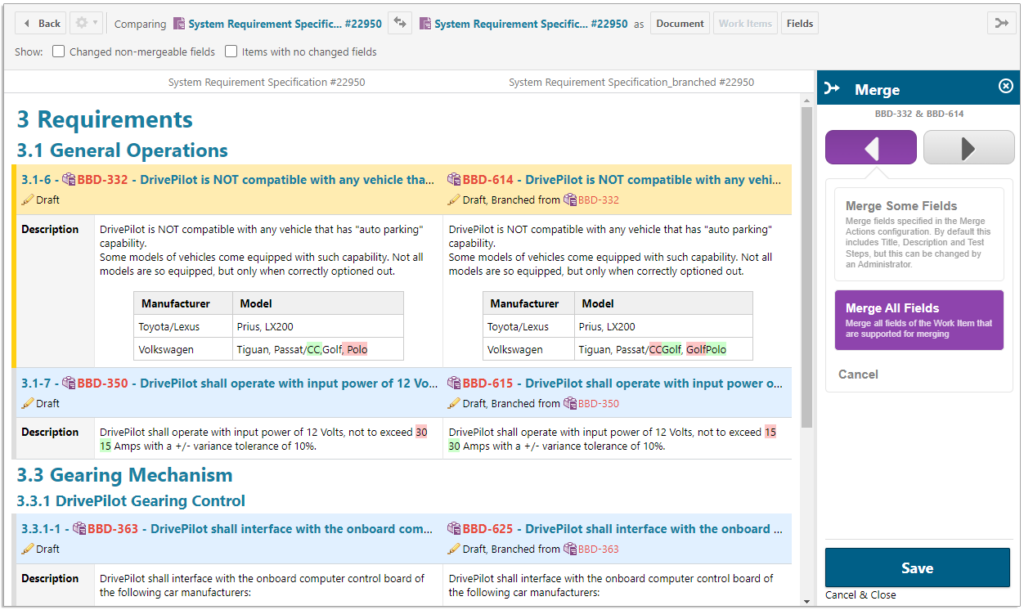
Three new display options are available in the Work Item comparison view to control how the information is presented:
- Show changed non-mergeable fields – Choose to either show or ignore differences in initialized fields or fields not supported by manual merge (e.g., Status). Previously, these fields were always shown in the comparison, which may have made the view harder to read.
- Show items with no changed fields – Choose to either show or ignore Work Items that have been overwritten or frozen but have no fields changed between the left and right side of the comparison. Showing these Work Items provides a fuller view of the differences and opens access to advanced merge options.
- Show items filtered out on one side (when a filter is active) – Choose to either show or ignore the pairs of Work Items that have been “Filtered out” on one side of the comparison view. The pairs of Work Items that do not match the filter on both sides will remain hidden.
Enhancements in Test Management
Easy Planning of Test Runs from LiveDoc Baselines
Polarion 2404 introduces significant improvements designed to enhance test management and execution. A key feature is the creation of Test Runs from historical document revisions, which ultimately streamlines the re-validation process. This feature is available for the “From LiveDoc on Create” strategy.
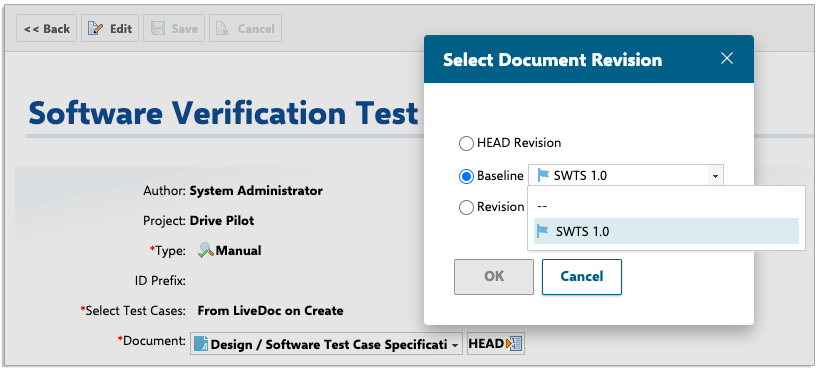
Further Test Planning Enhancements
Planning manual test cases is now easier than ever, thanks to the new ability to switch Test Runs directly from the Test Run Planning Sidebar.
The update also extends support for the Project Span in the ‘By Query on Create‘ strategy during Test Run creation, making planning more flexible and improving project management capabilities.
Delete and Correct existing Test Records
Another significant enhancement is the option to correct existing Test Records in Test Runs. The update now lets you delete Test Records that are mistakenly recorded or obsolete. It also introduces the ability to set custom permissions for executing Test Runs and adds a new permission to manage the deletion of Test Records.
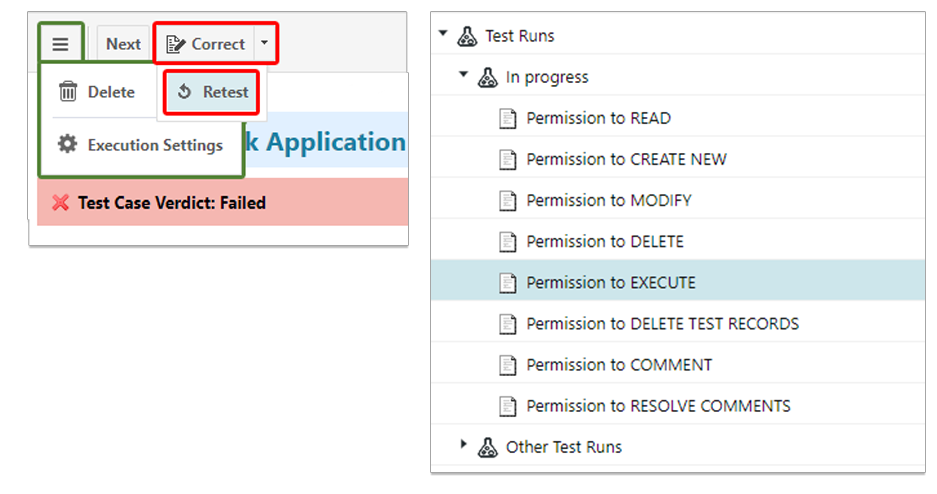
Test Steps table layout update
We also improved how columns in the Test Steps table are added and removed, ensuring all columns and their data always remain in the column order configured in Administration.
Import and Export Improvements
ReqIF now supports Polarion Test Steps
It is now possible to import and export Polarion LiveDocs that contain test steps as part of a test case using the ReqIF standard. A new option allows you to include test steps in the ReqIF definition, making sharing test specification documents between different Polarion instances much easier.
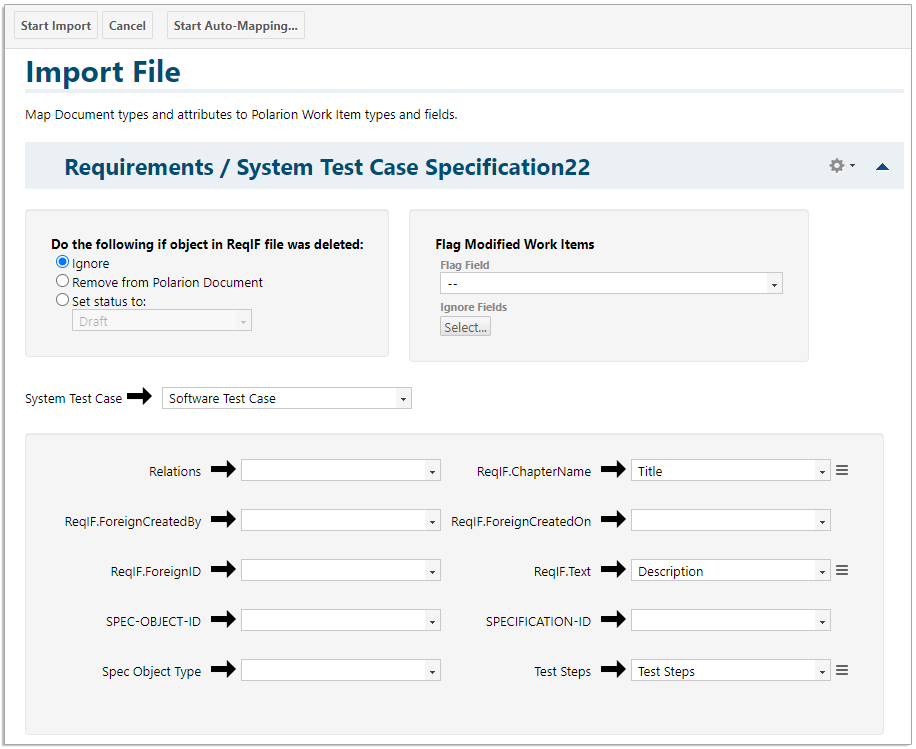
Import ReqIF IDs to Polarion Custom Fields
We added support for importing the internal SPECIFICATION-IDs and SPEC-OBJECT-IDs ReqIF fields. You can import their values as custom fields to Polarion Work Items. This information can be handy if a ReqIF import experiences problems, and you must reconstruct the mapping between ReqIF and Polarion items.
Support for Cross References in ReqIF Export
Polarion now exports Cross-References in LiveDocs to ReqIF. Because ReqIF does not have the concept of a Cross-Reference, these “links” are exported as standard HTML hyperlinks and look similar but not identical.
Improved ReqIF/RIF templates dialog
We improved Polarion’s display of ReqIF/RIF templates. Now, a globe icon indicates Global templates and a folder icon indicates a template on the Project level.
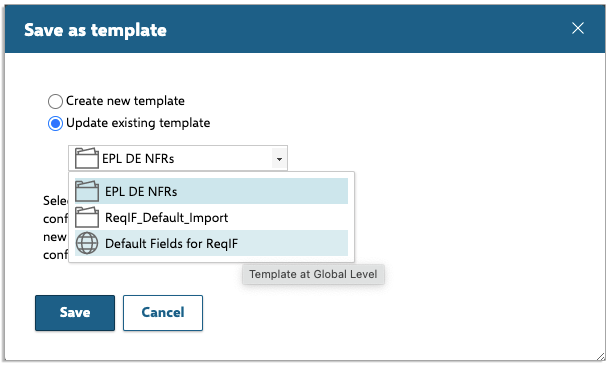
Export Priority field as a number to Excel
A new advanced option was added for Exporting Work Items. You can now export the Priority field as a number. When you do, you’ll get its float value rounded to four decimal places in Excel.
Export Traceability Matrix into xlsx format
The “Microsoft Excel table” export in the Traceability Matrix view has been updated. It now supports the up-to-date xlsx format, which also provides a more generous limit on the maximum number of columns that can be exported at once.
REST API Improvements
Polarion’s REST Description file is now published under an Apache 2.0 license, so you can freely include it in your projects and publish Polarion REST API-based extensions that require the REST API Description file as part of the package.
Now, let’s go through the bigger REST API improvements one by one:
Baseline Queries
Collection endpoints now allow you to include a revision as input and return a set of objects that are part of that revision. To always get the same set of results, set a specific revision when getting a collection of objects like Work Items, Plans, Test Runs, or Users.
Access Management
You can now restrict REST endpoint access via a set of REST API Endpoint permissions. The REST API Endpoint permissions categorize the endpoints into:
- Global endpoints: Endpoints where the Project is not part of the path. e.g.: PATCH /users/{userId}, GET /jobs/{jobId}
- Project endpoints: Endpoints where the Project is part of the path, e.g.: GET /projects/{projectId}/workitems/{workItemId}/approvals
There are four types of REST API Endpoint permissions: GET, PATCH, POST, and DELETE. For project-level endpoints, you can also set project-specific permissions.
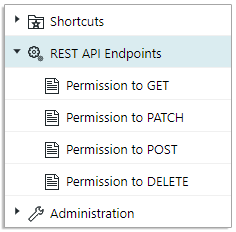
Personal Access Token Management
Privileged users (with the Global, Manage User permission) can now create or renew the Personal Access Tokens of other users in both the UI and via the Java API.
Non-privileged users can also renew their own expired (or nearly expired) tokens.
Enumerations
Polarion’s REST API now supports custom object enumerations. You can work with any custom object enumeration factory based on Polarion Prototypes or Strings.
Polarion now supports previously unsupported Custom object prototypes (Build, Collection, Documents & Pages, Project Group, Time Point, and Wiki Page) as String enumerations.
Plugins that provide custom object Enumerations must use the following for these enumerations, or they are treated as default String enumerations:
com.polarion.platform.persistence.IEnumObjectFactory.getEnumOptionPrototypes()
Test Management
With Polarion’s REST API for Test Management, you can now:
- PATCH and DELETE for Test Runs, Test Record attachments, Test Record Test Step Result attachments.
- PATCH a specific Test Step Result from a specific Test Record.
- PATCH multiple Test Records.
- DELETE for Test Runs, Test Record attachments, Test Record Test Step Result attachments, Test Parameter Definitions, Test Parameters, and Test Run attachments.
- PATCH Test Run comments. (Only to resolve a comment, not to change its text.)
- DELETE Test Record from a Test Run.
- Create a Test Run Template using a specific Document revision with the “From LiveDoc on Create” strategy.
LiveDoc Documents
It is now possible to work with Referenced Work Items as Document Parts.
Automatic Merge
REST API now supports the Automatic Merging of LiveDoc Documents. The Automatic Merge endpoints are asynchronous, and you can Pull or Push merges bidirectionally between master and branched Documents.
Integrations
Polarion connector for Simulink®
The Polarion connector for Simulink was updated to version 3.3.1. This update includes the following improvements and fixes:
- Improved support for working with Collections and change flow.
- Improved traceability, including linking MATLAB Code with Polarion requirements and Work Items.
- Optimized model diagrams to fit into the LiveDoc canvas.
- Added support for MATLAB 2024a (including Simulink, Stateflow, System Composer, Simulink Requirements Toolbox, and Simulink Test.)
- Several bug fixes
The new version of the connector is available for free to all Polarion customers and can be downloaded from our extension page here https://extensions.polarion.com/extensions/397-polarion-connector-for-simulink
MathWorks, MATLAB, and Simulink are registered trademarks of The MathWorks, Inc. in the United States and other countries.
Teamcenter Connector is now Teamcenter Linked Data Integration
To help our customers easily distinguish between our Teamcenter integrations, we renamed the “Teamcenter Connector” “Teamcenter Linked Data Integration” (Linked Data indicating that it is an OSLC-based integration.)
We also simplified how we release the Teamcenter Linked Data Integration. We’ve harmonized both its version numbering and release cycle to match Polarion. In the future, you can easily pair your Polarion version YYMM with the appropriate, well-tested Teamcenter Linked Data YYMM version.
Improvements in the OSLC CreationFactory
We continued to improve our OSLC CreationFactory functionality and refined the format of the Time data type. We also now support the rdf:datatype XML attribute. See Polarion’s Help for more information.
Synchronization of Attachment links with Jira Connector
To match the previous visual and readability improvement on how links appear in Polarion rich-text, we have enhanced the Jira integration framework to support synchronizing these improved links.
Usability Enhancements
Embedding of icons and images into Notifications
We improved the handling of icons and attachments in Polarion Notifications. Icons and attachment thumbnails are now embedded directly into the notification’s body, bringing the following benefits to Polarion users.
- Notification e-mails contain all the icons even if the e-mail client cannot access the Polarion server.
- The modified images in the rich-text content are embedded into Notifications as previews.
The maximum size of embedded attachments is limited to prevent large e-mails with many Motifications from cluttering user mailboxes. If the attachment limit is exceeded, only a placeholder for an image is displayed in the Notification.
Week numbers in Date Picker
All Date Picker components in Polarion now display the week numbers before each week’s line. Multiple standards describe week number systems with varying first and last days. We selected the ISO week date system described by ISO-8601 for this feature.
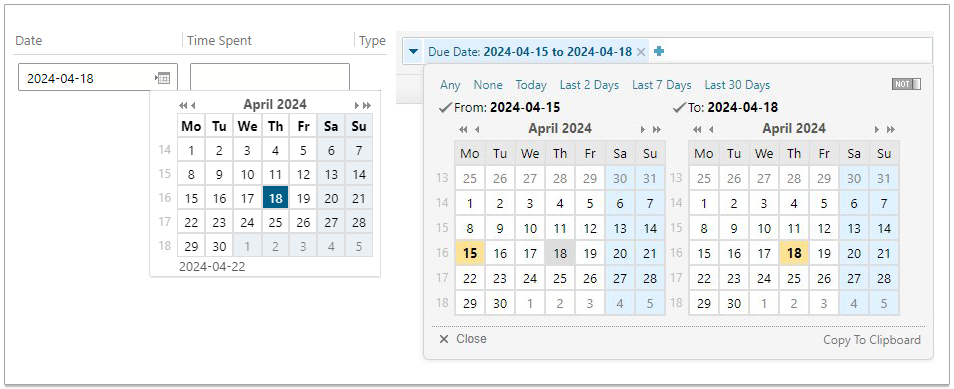
Further usability improvements
At Polarion, we understand the importance of usability in software. Even small improvements can make a big difference in your overall experience. In Polarion 2404, we’ve continued our efforts to enhance usability by implementing several small improvements across the application.
- Users looking for more customization options can now select custom colors directly within the rich text editor via the eyedropper icon.
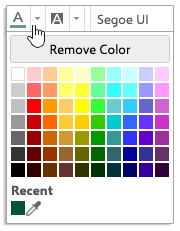
- We introduced a “Scroll to Top” button in the Work Item form making navigating your Work Items even easier.
- The recently introduced user picker widget was enhanced to support standard keyboard interactions, allowing you to add users with fewer mouse clicks. We also added a “Me” option to quickly select yourself through the new picker.
- Finally, we’ve revamped our demo personas to be more inclusive and representative of our diverse user base. Introducing a mix of male and female Polarion users from different regions ensures that our demo data aligns with today’s diversity and inclusion standards.
Cloud
Polarion X integration with Teamcenter X
An increasing number of our customers are embracing the Siemens Xcelerator portfolio and cloud solutions, including Polarion X and Teamcenter X. In this release, we enabled the direct integration of Polarion X and Teamcenter X. This integration allows customers to create requirements specifications in Polarion X and seamlessly publish them to Teamcenter X for use and tracing to the rest of the product artifacts. By leveraging Siemens Security and Access Management (SAM), this integration ensures our users have a secure and smooth experience.
Polarion X user management with Siemens Admin Console
The Siemens Xcelerator Admin Console is a unified management platform for the Siemens Xcelerator Enterprise Cloud Account Subscriptions. It is designed to simplify the administration of your Siemens Xcelerator portfolio, providing a centralized location for various administrative tasks, including user and administrator management. The console also offers a comprehensive view of all purchased products.
Starting with this release, all new Polarion X customers will be onboarded through the Admin Console. This will facilitate the management of Polarion X users and the activation of enhanced security measures such as multi-factor authentication and single sign-on, improving both the security and efficiency of the user experience.
Security
Restricting Lucene search to allowed projects only
We have made a change to Apache Lucene query results that will only display artifacts from Projects that the user has permission for. This change is now available by default in version 2404, and no additional configuration is required. As a result, users who conduct Work Item searches in global or project group contexts will no longer see redundant rows labeled “You cannot see this object” in the query results.
It also increases your security by hiding unreachable projects from users when they do not have permission to view them.
If your repository contains a large number of projects (more than 1000) and has a large number of users, you may notice some performance degradation when the Work Items query results load in the tracker or as part of your reports. Feature tuning can help improve this, or you can switch it off. You can find more details in our Deployment and Maintenance Guide.
Restricting User visibility to project peers
Allowing users from different projects to access each other’s data can lead to privacy violations. Users typically expect their data to remain confidential and not be accessible to others outside their project.
By default, users can now only view other users who share the same projects with them, restricting the visibility of the whole user base to global and project admins only. A new permission for viewing the users was introduced together with a new dynamic peer role.
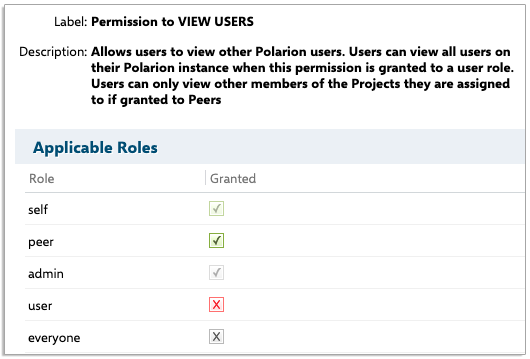
Restricting Access to User Profile Pages
Limiting access to user profile data is essential for preventing unauthorized access and data breaches. In Polarion 2404, we’ve introduced measures to ensure that users can only view their own profile by default.
Users must have the “Manage Users” permission to view another user’s profile. If the “peer” role is applied along with the “Manage Users” permission, users can only view the profiles of other users with whom they share a common project.
Users who do not have the “Manage Users” permission will receive a notification informing them that they do not have the required permission if they attempt to view another user’s profile.
Reflecting permissions when sending e-mail notifications
New restrictions were added based on the project membership and project-level permissions for sending email Notifications.
- If a user is added as a Watcher to a Work Item in a project and is removed or does not have permission for that project, they no longer receive Notifications when the Work Item is updated.
- If a user does not have read permissions for a Work Item, Page, or Document, even if they are part of the Target Notification group, they no longer receive notifications for those artifacts.
Introducing SALT licensing
In Polarion 2404, we introduce support for the Siemens Advanced Licensing Toolkit (SALT), fundamentally transforming the landscape of licensing flexibility and automation for our customers. SALT, built upon FlexLM, significantly enhances license delivery, providing a more efficient and seamless experience.
While Polarion’s proprietary licensing remains the default choice for both new installations and updates, SALT emerges as an alternative mechanism. Looking ahead to future releases, starting with Polarion 2410, SALT will assume the role of the default licensing method, aligning Polarion seamlessly with the broader Siemens portfolio.
Notably, in SALT licenses, we have eliminated the running instances counter from the license file. It’s important to emphasize that all previous releases and their forthcoming patches will exclusively function with the Polarion proprietary license (activation code).
Obtaining a SALT license
- New Customers will automatically get both license types. The FlexLM license file and the Polarion Activation key. They must select one method to use.
- Existing Customers can use existing, valid Polarion License keys to re-activate Polarion. Customers can also request a SALT license for 2404 through their Account representative or Support Center.
- Upon License Renewal, customers will get both licenses for 2404.
In 2410, we plan to stop automatically delivering the proprietary Polarion licenses (activation keys).
Only SALT licenses will be provided, and proprietary licenses will provided on demand.
Using SALT licenses
To utilize SALT licenses:
- Download and install the Siemens License Server from the Support Center.
- Upload your SALT license into the server.
- Configure Polarion to utilize SALT licensing and (re)start the application.
- After restarting, Polarion retrieves the license data from the SALT server and activates the application.
- Once Polarion starts successfully, users can log in.
The same process applies to re-activation.
If you add new licenses to the SALT server, Polarion needs to reload them. Polarion communicates with the SALT server when a user logs in and out, maintaining track of available licenses.
See Install and configure the SALT licensing server for Polarion on Support Center for details.
Licensing for different Polarion versions
Currently, only Polarion 2404 supports SALT. We plan to enable different versions of Polarion to connect to a single SALT server in the future.
Managing licenses in a Cluster installation
In a Cluster installation, the SALT configuration property to enable SALT licensing must be set on all Instance/Shared Services machines and the Coordinator. Make sure that you configure the Coordinator to point to the SALT server URL for seamless license management.
Other Licensing Improvements
We also enhanced licensing so that admin users receive “License will expire in N days” messages. Now, only relevant parties are alerted to impending license expirations, and you can even customize the notification period before expiration.
In Polarion 2404, the assigned license type now appears in the user detail screen so users know what license is currently assigned to them.
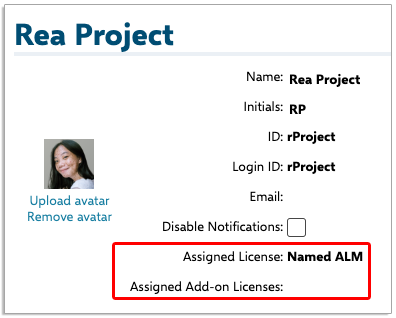
Performance and Scalability
In Polarion 2404, we addressed several performance issues to ensure a smoother and faster user experience. Here are the key improvements.
Performance Improvements
- LiveDoc load times were improved, especially when the Work Item Presentation layout displays the Linked Work Items field as a table. Our tests on large customer Documents have shown an impressive 75% improvement for regular users.
- The Document picker component, used in Collections and Test Runs templates, has been reworked to provide much quicker response times, even in projects with thousands of LiveDocs. Memory allocation while loading was also significantly reduced.
- The recognition of the Work Items hierarchy on large Documents has significantly improved the ReqIF round-trip import by up to 80%.
- Creating Document branches and importing Documents from Word are also 10% faster.
Reindex and Startup Improvements
- We’ve reduced reindexing time by 30-40% on large customer repositories by optimizing Subversion operations during object map creation. This optimization minimizes downtime during updates to new Polarion versions or planned reindexing.
- Memory consumption during reindexing was also significantly decreased, especially for the largest customer repositories. This improvement allows our largest customers to reindex their data without the need for additional server-side memory.
- We fixed the caching logic for large manual Test Runs with attachments that are replaced by new versions via History. This enhancement resulted in an over 50% decrease in indexing time for these objects.
- We disabled the legacy automatic recognition of build artifacts feature by default. This change speeds up Polarion’s reindexing and startup, particularly on instances with a large number of projects.
Optimized session replication in a Cluster
In Polarion 2404, we’ve enhanced session replication to ensure a seamless user experience when users are rebalanced between different Polarion application nodes in a Cluster.
Session replication shares the user session across all nodes, eliminating the need for users to log in every time they move to another node.
We have optimized the session replication logic, reducing the number of replications by an impressive 97%. This optimization minimizes the load on the network and Polarion application nodes during session replication, resulting in a smoother and more efficient user experience.
Notable Issue Fixes
At Polarion, we’re committed to providing the best possible experience for our users. With every release, we tirelessly work to fix bugs, enhance performance, and improve the user interface. Whether you’re using Polarion on-premise or in the cloud, we’re dedicated to ensuring your experience is smooth and seamless.
Click the link below to explore all the bug fixes, performance improvements, and enhancements, we’ve delivered in Polarion 2404:
Explore the Complete List of Enhancements and Fixes
Deprecations
In our commitment to keeping Polarion up to date, we periodically evaluate and clean up outdated features. Our Deprecation and Removal Plan outlines our future plans for deprecating and removing existing functionality.
Deprecated or Removed in Polarion 2404
Update Information
Polarion 2404 is an update of Polarion ALM, available to all customers with a current maintenance subscription. This update is your gateway to the latest enhancements and security fixes. Staying up to date with our latest release ensures you benefit from new features, enhanced security, improved usability, and better performance.
To download the update distribution package, please visit this link.
For comprehensive details on the update process, you can find the bundled 2_How_to_update_Polarion.txt within the update distribution package.
Conclusion
With Polarion 2404, we’re committed to providing you with the best possible experience. From the automatic merging of LiveDoc changes, improved test management, and enhanced project and user isolation, this release is packed with features designed to make your workflow smoother and more efficient.
We’re constantly listening to your feedback and working to incorporate it into our updates, ensuring that Polarion remains the leading choice for collaborative software development and project management.
Thank you for choosing Polarion. We hope you enjoy the new features and enhancements in this release. Stay tuned for more updates and improvements in the future!
Regards,
Radek Krotil,
Polarion ALM Product Management


